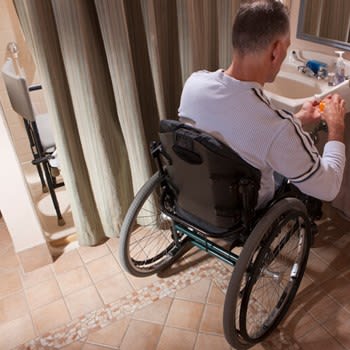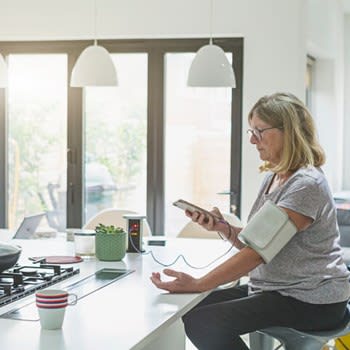Does Medicaid Cover Portable Oxygen Concentrators?
- Medicaid may cover portable oxygen concentrators if they’re considered medically necessary. Learn more about coverage options and the cost of purchasing a POC.
For Medicaid enrollees who require supplemental oxygen due to asthma, COPD and other pulmonary conditions, portable oxygen concentrators can deliver oxygen therapy on the go. Although coverage varies by state, Medicaid may cover portable oxygen concentrators if they’re considered medically necessary. Keep reading to learn more about the coverage options and costs associated with these mobile devices.

Learn More About Medicare
Join our email series to receive your free Medicare guide and the latest information about Medicare.
By clicking "Sign me up!" you are agreeing to receive emails from HelpAdvisor.com
Thanks for signing up!
Your free Medicare guide is on the way.
Make sure to check your spam folder if you don't see it.
Does Medicaid Cover Portable Oxygen Concentrators?
Because Medicaid is administered by individual states, coverage rules vary widely from place to place. However, many Medicaid programs cover up to 100% of the cost of portable oxygen concentrators if they’re considered medically necessary and meet the state's definition of durable medical equipment. For up-to-date coverage information on portable oxygen concentrators for your state, contact your local Medicaid office.
What Equipment Does Medicaid Pay For?
Although Medicaid coverage terms are state specific, many programs cover durable medical equipment. DME is typically defined as equipment that’s medically necessary, suitable for home use and can hold up to repeated use. Most states also require DME to be cost effective, which usually means that programs cover only the most basic version of a device.
Types of devices that may be covered under Medicaid include:
- Oxygen monitors and concentrators
- Blood sugar meters
- Infusion pumps
- CPAP machines
- Nebulizers
- Suction pumps
- Traction equipment
- Walkers and wheelchairs
If a device is covered under your state’s Medicaid program, it typically must be purchased through a Medicaid-approved supplier, and you must provide a medical justification letter from your doctor detailing why you need the equipment.
What Is a Portable Oxygen Concentrator?
A portable oxygen concentrator delivers supplemental oxygen to individuals who experience drops in blood oxygen levels due to medical conditions such as COPD, COVID-19 and lung cancer. The device draws oxygen from the air around it, so it doesn’t require refillable tanks, making it smaller and lighter than stationary oxygen concentrators. Most POCs are shorter than knee height and are designed to be carried or carted around.
Portable oxygen concentrators come in various sizes, shapes and colors. However, most units feature similar components, which include:
- A power switch
- A knob to adjust the flow rate
- An alarm indicator that signals a loss of power
- A replaceable intake filter
- An outlet for the nasal cannula
- A rechargeable battery or a plug-in power source
Many units also offer optional adapters that plug into vehicles so the POC may be used during travel.
The Benefits of a Portable Oxygen Concentrator
Because portable oxygen concentrators don’t require refillable oxygen tanks, their primary advantage is convenience. You won’t have to worry about the availability of tanks or the mechanics of replacing them, and the device’s smaller size optimizes mobility.
Portable oxygen concentrators also offer various other benefits, including:
- Ease of use. Most POCs feature user-friendly digital displays, and many units alert you to a potential malfunction by beeping, so there's no guesswork.
- Because POCs make their own air, you don’t have to worry about a tank rupturing.
- POCs typically include multiple settings, including pulse-flow and continuous-flow delivery, so you can receive oxygen in the way that’s best for you.
- Because POCs are small and light, they let you move around freely. That means you can receive supplemental oxygen while performing your normal daytime activities or at night to help maintain your blood oxygen level while you sleep.
What Is the Cost of a Portable Oxygen Concentrator?
If you’re paying out of pocket, standard stationary in-home oxygen concentrators typically cost anywhere between $550 and $2,000. Portable oxygen concentrators are substantially more expensive, with costs ranging between $2,000 and $6,000. Variations in price are generally due to differences in brand, features and the weight of the unit.
When considering the overall cost of using a portable oxygen concentrator, you'll need to factor in other expenses associated with the unit's use and upkeep, including:
- Electricity
- Tubing
- Replacement filters
- Battery replacement packs
- Accessories such as carrying cases, carts and specialty masks
Other Considerations When Purchasing a Portable Oxygen Concentrator
If you’re shopping around for a portable oxygen concentrator, cost isn't the only factor worth considering. Depending on your medical condition, lifestyle and intended use of the device, you may want to consider other important aspects of a POC.
- Size and weight: Portable oxygen concentrators tend to be classified as small, medium or large. Small POCs typically weigh less than 5 pounds, making them easy to carry, but they typically have a lower oxygen capacity than larger models. Large units, which run upwards of 45 pounds, tend to have a higher oxygen capacity and may include additional features, such as a built-in nebulizer. However, although these larger models are still meant to be portable, they require a mobile cart.
- Batteries: Most POCs use lithium-ion batteries, which are compact, lightweight and eco-friendly. A unit’s battery life can vary considerably depending on the settings being used, and some high-end POCs may run for as long as 13 hours without being recharged, making these units ideal for individuals who plan to be on the go. Users may also want to consider the length of time it takes to recharge the batteries, how many times a battery may be recharged before it must be replaced and the cost of replacement batteries.
- Accessories: Different manufacturers may offer different accessories. Available accessories may include travel kits, backpacks and other carrying cases, mobile carts, battery chargers and a variety of oxygen masks. If you need or want a particular type of accessory, make sure your chosen unit accommodates that item prior to purchase.
- What’s included with the unit: Most portable oxygen concentrators come with the basic equipment needed for operation, including a power cord, battery and starter filter. However, many manufacturers also provide tubing, an oxygen mask and a carrying case or rolling cart.
- Warranty: POC warranties typically last 1-5 years. Individuals who anticipate heavy use of the device may want to invest in a unit with a longer warranty period.
- FDA approval: FDA-approved oxygen concentrators require a prescription. Units that are sold online without a prescription do not have FDA approval.
Purchasing a Portable Oxygen Concentrator
If you think you may benefit from having a portable oxygen concentrator, discuss options with your doctor, who can provide you with a prescription for the device. Seniors who have health coverage through Medicare, Medicaid or private insurance may want to discuss the terms of reimbursement with their individual carrier before making a purchase.



